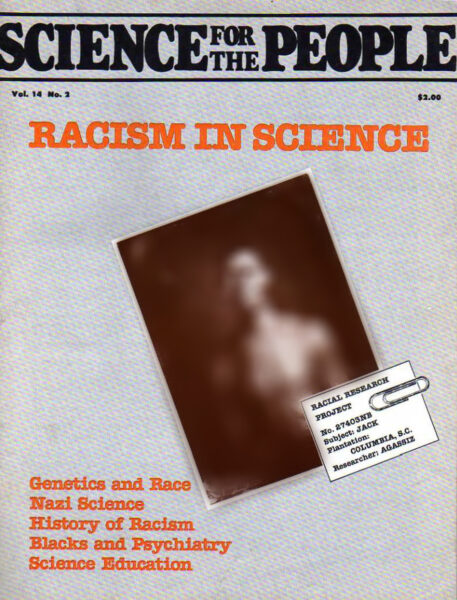A History of the Concept of Race
Science for the People Vol. 14, No. 2, March–April 1982
By Walda Katz-Fishman & Irving Wainer
Volume 24, Number 1, Racial Capitalism
July 5, 2021
Race has been the central axis of social struggle in the United States since its inception, but the last few years have brought the racial struggle to the front of sociopolitical discourse. From the “Unite the Right” rally in Charlottesville in August 2017, the national and global protests of the Black Lives Matter movement fueled by the cruel murder of George Floyd in Minneapolis, and the insurrection at the Capitol in January of this year energized by the words of Donald Trump, the issue of race is no longer “dog whistles” in the background of the political discourse. It is now out in the open.
The necessity to confront and defeat racism is one we should approach critically. It is perhaps easier to pinpoint the discriminatory rhetoric of white supremacists than it is to recognize and challenge the ways in which racist systems have shaped us as individuals. Almost forty years ago, in 1982, Science for the People magazine published an issue devoted to offering a “deeper understanding of how racism works,” and how to oppose it. It included an article written by Irving Wainer and myself that examined how scientific theories have fostered racism. This article is still relevant today, and for that reason the current editors have decided to reprint a major section of it in this issue. It is our hope that this article serves as an educational tool to fight racism in political systems and cultural discourse, and within ourselves.
We find ourselves today at the intersection of global crises: an irreversible capitalist economic crisis, an ecological catastrophe engulfing the planet, a deadly viral pandemic, and the threat of resurgent fascism throughout the world. Undergirding the structures and institutions of American society is the intensifying white supremacy produced and reproduced by US policymakers representing the interests of the multi-billionaire investor class—from the origins of North American capitalism in settler colonialism, genocide, and chattel slavery, to centuries of rebellion, reform, reaction, state violence and terror. White supremacy—infused throughout all material and ideological forms of society and humanity’s relations with nature—was and is an essential strategic tool of capitalist rule.
The present urgency is driven by the recognition that a significant segment of the governing circles of the United States seems willing to abandon the traditional flawed but democratic forms of governance in favor of harsh autocratic rule. The multiracial struggles around Black lives, climate change, and the unequal burden of the raging COVID-19 pandemic have revealed the deepening economic inequality and racial and gender oppression that have become commonplace in a capitalist system that cannot survive without discrimination. In the twenty-first century we have the opportunity to take this historic intellectual and political struggle to its resolution—to abolish the capitalist system that requires white supremacy.
—Walda Katz-Fishman
•
In the interest of accountability, we, the editorial collective, have excluded the images associated with the original article “A History of Race” from republication. The subjects of the photographs, Renty and Delia, father and daughter, were forced to strip naked for a series of photographs commissioned by Harvard professor Louis Agassiz. Agassiz, a renowned biologist and geologist, used these photographs as part of his efforts to “prove” the inferiority of Black people and to justify their enslavement.
However, by republishing sections of this article with the images omitted, we hope to provide our readers with tools to critically examine the concept of race by understanding its history and, consequently, science’s role in the cultural justification of race and racism. Renty and Delia’s images, under the possession of Harvard University, perpetuate the exploitation of enslaved Africans and directly oppose our mission.
A Massachusetts court recently dismissed a lawsuit brought forward by Tamara Lanier, a descendant of Renty and Dalia, asking Harvard to return the images to her family. Harvard has profited and will continue to profit from the immortalization of their suffering. Renty and Delia’s descendants, on the other hand, must live with how their family members’ bodies continue to be considered property long after slavery’s abolition.
The author, Walda Katz-Fishman, unites with us in this decision to exclude the pictures from republishing.
—Vol. 24, No. 1 Editorial Collective
•
 In the last 15 years there has been a resurgence of “scientific” theories and research suggesting the inherent biological inferiority of certain “races” in particular of blacks in the United States. The most well known examples are the works of Jensen, Shockley and Herrnstein on “race” and IQ. These “scientific” theories are not new products of recent research, but have a long history dating back to the 1830s and the defense of slavery in the US. This history is an example of the interaction of science and society and the abuse of the former to meet the needs of certain classes in the latter. It is an example of the fact that scientific theories do not exist as detached and isolated “truths” in a social vacuum. Rather, they exist within the context of contemporary political, economic, and social forces and can only be understood when considered in this context. It is a history which must be exposed and understood so that the current outbreak of “scientific” theories of “racial inequality” is the last.
In the last 15 years there has been a resurgence of “scientific” theories and research suggesting the inherent biological inferiority of certain “races” in particular of blacks in the United States. The most well known examples are the works of Jensen, Shockley and Herrnstein on “race” and IQ. These “scientific” theories are not new products of recent research, but have a long history dating back to the 1830s and the defense of slavery in the US. This history is an example of the interaction of science and society and the abuse of the former to meet the needs of certain classes in the latter. It is an example of the fact that scientific theories do not exist as detached and isolated “truths” in a social vacuum. Rather, they exist within the context of contemporary political, economic, and social forces and can only be understood when considered in this context. It is a history which must be exposed and understood so that the current outbreak of “scientific” theories of “racial inequality” is the last.
Early Scientific Theories of Race
After “race” as a scientific term was first introduced by the French philosopher-scientist Georges L.L. de Buffon in 1749, the term was expanded into a system for the classification of the varieties of humankind by Johan Friedrich Blumenbach in his book On the Natural Variety of Mankind written in 1775. Both Buffon and Blumenbach recognized that all human beings belong to a single species and used race as a convenience to distinguish between certain geographically localized groups. Buffon’s and Blumenbach’s use of the term race reflected the times in which they lived; an era where the American and French Revolutions were expounding the philosophies that “All men are created equal” and “Liberty, Equality, Fraternity,” and a time when the African slave trade purported to save souls.
The Slave Period
The concept of race remained a method of simple classification for almost 60 years until it was transformed into a component of a scientific theory defending slavery in the southern part of the US. This change was brought about by a number of related political, intellectual and economic developments. By the early 1800s, slavery was under attack. In England, manufacturing had reached the stage of development where it was more profitable to export the raw materials of West Africa than its people. At the same time, the slave trade was ceasing to be economically advantageous for the British West Indies sugar plantations. In 1804, the people of Haiti broke their bonds of slavery and established the first independent republic in Latin America-an event which sent shivers through slaveholders. As a consequence, in 1808, the British government responded to these developments by prohibiting the slave trade in British vessels, and in 1833 slavery was abolished in the British Empire.
The concept of race remained a method of simple classification for almost 60 years until it was transformed into a component of a scientific theory defending slavery in the southern part of the US.
The Abolitionists
The American abolitionist movement was one of the key political and intellectual developments that proved central to the history of racism. It grew from a religious revival known as the Great Awakening, which began in New England in the 1740s. This movement attacked the religious justifications for slavery. The first Great Awakening did not produce an anti-slavery movement. This was accomplished by the Second Great Awakening which swept the country between 1825 and 1832, producing in 1833 the first national abolitionist organization, the American Anti-Slavery Society. From its inception, the organized abolitionist movement propagandized against slavery. Millions of pieces of literature were produced attacking slavery on religious and moral grounds as well as pronouncing it contrary to the fundamental principles of the American way of life. This material was distributed in both the North and the South and was so effective that by 1835, President Andrew Jackson was forced to appear before Congress and call for the passage of “a law as will prohibit under severe penalties, the circulation in the Southern states through the mail, of incendiary publications intended to instigate the slave to insurrection.”
The abolitionist movement grew because it found a favorable environment in a changing North, where a growing transportation system nurtured a developing capitalism based on the production and sale of agricultural commodities and manufacturing. The completion of the Erie Canal in 1825 opened up the northern regions of Ohio, Indiana and Illinois and created large regional markets for agricultural commodities and industrial products rather than merely local ones. By 1827, for example, wheat from central New York was being sold at Savannah, Georgia more cheaply than wheat from central Georgia.
By extending the domestic markets, advances in transportation hastened the industrialization of the North. This was especially felt in the industry producing cotton cloth. In the 1820s there were only about 1000 people engaged in this industry. At the end of the next decade, this number had grown to 10,000, and by 1840, there were 1200 cotton factories in the US operating 250,000 spindles, two-thirds of them in New England.
As the economic system of the North grew it intensified the economic and political conflicts between the North and South. The basis of this conflict was the struggle for domination between a system of capitalist production using free labor which was primarily concentrated in manufacturing and small farming (North), and capitalist production with slave labor which was primarily concentrated in the production of agricultural goods for the international market (South). By the mid-1800s, the two regions emerged as separate economic and political entities. The Civil War decided which was destined to dominate the other. One way to view the abolitionist movement is as the ideological reflection of this struggle in the North. The “scientific theory of race” was the South’s response. In order to understand why a “scientific theory of race” developed, it is necessary to look at the South of the 1830s. By 1830, the commitment of the South to capitalist agriculture-to the production of a stable crop for a world market-was the dominant fact of Southern life. Karl Marx described the effect of this development on the slave:
But as soon as people, whose production still moves within the lower forms of slave labor, corvee-labor, etc., are drawn into the whirlpool of an international market dominated by the capitalist mode of production, the sale of their products for export becoming their principal interest, the civilized horrors of overwork are grafted on the barbaric horrors of slavery, serfdom, etc. Hence the negro labour in the Southern states of the American Union preserved something of a patriarchal character, so long as production was chiefly directed to immediate consumption. But in proportion, as the export of cotton became of vital interest to these states, the overworking of the negro and sometimes the using up of his life in seven years labour became a factor in a calculated and calculating system.
The increase in the exploitation of black labor brought an increase in resistance. In 1831, Nat Turner led a rebellion in Southampton, Virginia. This was not the first slave rebellion, though. While earlier upheavals were met with a temporary increase in repression, this one resulted in major changes. “Black Codes” were made more restrictive throughout the South. “Laws were passed curbing the mobility of slaves through a system of patrols and passes, meetings of slaves were prohibited, educational possibilities were curtailed, and the possibility of manumission was reduced.” White Southerners also suffered from this wave of reaction. There were infringements of basic civil and personal rights, free speech, free press, free thought and constitutional liberty.
They argued from the empirical observations that people with black skins under the conditions of slavery did not have the educational, intellectual and political attainment of their masters, to the “scientific” conclusion that this inequality was biological and hence inevitable.
The Scientific Theory of Racial Inequality
Faced with external and internal attacks and no longer able to defend slavery in the old way, the Southern ruling class came to rely on a new, stronger defense of the slave system. As John C. Calhoun proclaimed:
It is not enough for the Southern people to believe that slavery has been entailed upon us by our forefathers. We must satisfy the consciences, we must allay the fears of our own people. We must satisfy them that slavery is of itself a right-that it is not a sin against God—that it is not an evil, moral or political. . . . In this way, and this way only, can we prepare our own people to defend their institutions.
Thomas R. Dew and William Harper responded to Calhoun’s call by uniting Buffon’s and Blumenbach’s system of classification with Aristotle’s defense of slavery: “He is then by nature formed a slave who is fitted to become the chattel of another person, and on that account is so.” Thus, the “scientific” theory of the natural inequality of different groups of humans was born as a justification of slavery on the basis of racial inequality.
The Southern race theorists asserted, yet never proved, the factual validity of the existence of distinct types of human beings called races. They argued from the empirical observations that people with black skins under the conditions of slavery did not have the educational, intellectual and political attainment of their masters, to the “scientific” conclusion that this inequality was biological and hence inevitable. They tried to convert a social and economic fact into a biological one. The purpose and effect of such a theory was to give the Southern slave owners a powerful ideological weapon. Slavery was no longer a moral question. It was the best possible system given the biological reality of the inequality between the races. An inequality which was the result of God’s work and which had been brought to light by science.
The Civil War and Reconstruction
The Civil War and Reconstruction temporarily pushed these theories aside. The enactment of the 13th, 14th and 15th Amendments along with the Civil Rights Acts of 1866 and 1870 established the legal position of equality between the races. However, in 1877, the Hayes-Tilden agreement ended Reconstruction and unleashed a wave of terror against the black and poor white people in the South. The concept of race and racial superiority once again flourished. It was now a justification of terror and oppression.
Numerous “scientific” articles supporting the segregation of the South were written during this period, 1890–1910. Many like the article written by Dr. Robert Bennett Bean entitled “Some Racial Peculiarities of the Negro Brain” were published in prestigious scientific journals. In this particular article which appeared in the September, 1906 issue of the American Journal of Anatomy, Dr. Bean defends segregation in education. He wrote:
Having demonstrated that the negro and the caucasian are widely different in characteristics, due to a deficiency of grey matter and connecting fibers in the negro brain, especially in the frontal lobes, a deficiency that is hereditary . . . we are forced to conclude that it is useless to try to elevate the negro by education or otherwise, except in the direction of his natural endowments.
The Period of Imperialism
Congressman Thomas W. Hardwick of Georgia used the same logic when he addressed the US House of Representatives in 1904 demanding the disenfranchisement of the black people. He said in part:
And who is the negro that he should dispute this demand? A race that never yet founded a government or built a state that did not soon lapse into barbarism, a race that never yet made a single step towards civilization, except under the fostering care and guidance of the white man; a race into whose care was committed one of the three great continents, and who has made it, ever since the remotest times, a land of utter darkness, until today the nations of Europe, in the onward march of irresistible civilization are dividing his heritage, the greatest of the continents among themselves . . .
Congressman Hardwick’s words are much more than an attack on voting rights. They represent a change that was taking place in the concept of race and its use. Race was no longer a justification just for the enslavement of a group of people, at this point it became a justification for the enslavement of whole nations.
Race was no longer a justification just for the enslavement of a group of people, at this point it became a justification for the enslavement of whole nations.
In the late 1800s the underdeveloped world began to change as the advanced industrial countries, primarily Great Britain, France, the US and Germany, began to divide these territories into private colonial empires. In the process they seized control over a number of what they termed “inferior races.” The “white man’s burden”—the theory that the domination of inferior races was a natural process which was raising the standards of human society and government—became part of the overt justification for colonialism. Thus, the colonial domination of a subject people becomes, like slavery had, an inevitable biological reality rather than a question of politics or economics.
It is time to argue clearly to the people of this country that “races” do not exist in any relevant sense, and that superficial physical differences between people can not legitimately be used to justify social, political or economic inequality. People must come to understand that the division of humankind into “Races” was the by-product of a theory that arose firstly as a defense of slavery, and which later was expanded to help justify imperialism. Hopefully when people become aware of the economic and political uses to which racial theories were put, it will be easier to convince them that the concept of race itself is scientifically indefensible.





